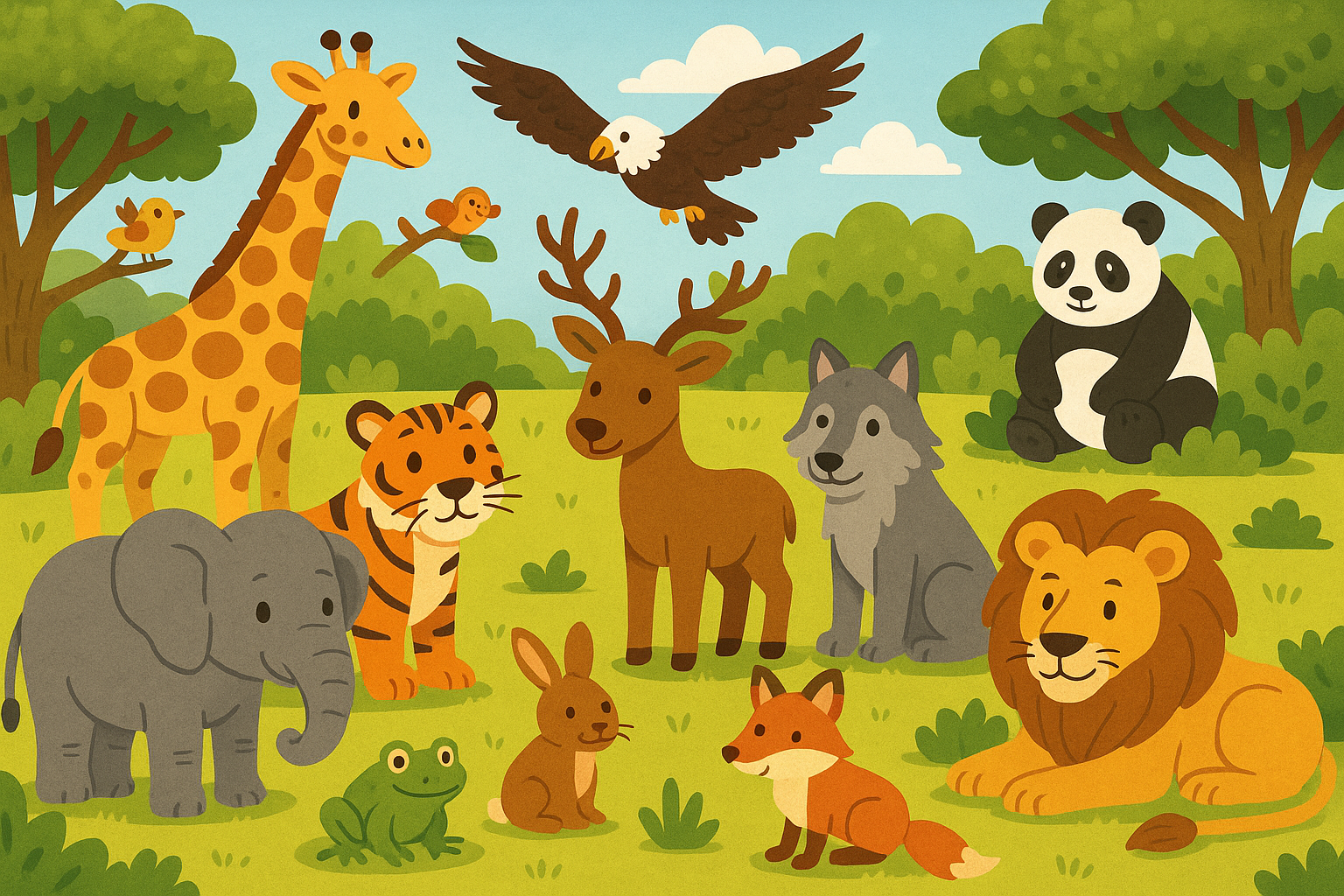🐾 Animal Sounds Safari
🎯 Target Skills
- Listening and sound recognition
- Language development
- Emotional connection with caregivers
🧰 Materials
- Phone or speaker
- Animal sound clips (YouTube, Spotify, etc.)
- Stuffed animals
- Household alternatives: toy animals, printed pictures, family pet, your own animal sounds!
👣 Step-by-Step
- 🎵 Find 3–5 animal sound clips online or make your own fun sounds!
- 🧸 Gather stuffed animals or images to match each sound.
- 📻 Play the sound and pause after—let your toddler look for the “matching” animal.
- 👂 Mimic the sound together. Try repeating it slowly and with exaggerated tone.
- 🚼 Encourage them to touch or point to the correct animal toy or image.
- 🤗 Give lots of cheers and smiles when they respond—no matter what they choose!
- 🔁 Repeat with different animals. Try switching up the order or playing them again later.
- 🎉 Add simple phrases like “That’s a cow! Moo!”
🤗 Parent/Caregiver Guidance
Use big expressions and an animated voice! Smile, laugh, and clap to show you’re having fun too. If your child loses focus, gently guide their attention back with excitement. Say things like, “Do you hear that? It’s a lion—ROAR!”
🧠 Why This Helps
Animal sounds introduce babies to rhythm, tones, and word patterns. They’re also the foundation for understanding and using words. Pairing sounds with visuals or toys helps link hearing with meaning.
📚 Research Foundation
- Speech development begins with sound recognition (Kuhl, 2004)
- Responsive interaction boosts early communication (Tamis-LeMonda et al., 2001)
- Auditory discrimination is a key early skill (Werker & Tees, 1999)
🦒 Animal Texture Hunt
🎯 Target Skills
- Sensory exploration
- Tactile curiosity
- Language and concept building
🧰 Materials
- 3–5 fabrics or textures (soft, bumpy, smooth, rough)
- Toys or images of animals with different textures
- Household alternatives: washcloth, sponge, faux fur, foil, towel
👣 Step-by-Step
- 🎒 Gather a few textured items and animal toys that feel different.
- 🖐 Let your toddler feel each texture. Say the name and describe it simply (“soft like a bunny!”).
- 🐘 Introduce the matching animal. “This feels bumpy, like an elephant’s skin!”
- 🧺 Place all textures in a small basket for the child to explore freely.
- 🗣 Narrate what they feel and do. Use clear, simple language.
- 🧠 Repeat with fun comparisons—“Rough like a crocodile!”
- 🐾 Let them choose a texture and try to match with a toy or image.
- 👏 Celebrate their curiosity and guesses!
🤗 Parent/Caregiver Guidance
Use a soothing, curious tone to guide their touch and talk. Narrate what’s happening: “You picked the fluffy one—it’s just like a lamb!” This helps connect touch and language.
🧠 Why This Helps
Touching and exploring different materials builds sensory processing and brain connections. It also helps your child make sense of the world and relate it to language.
📚 Research Foundation
- Multi-sensory input supports cognitive development (Shams & Seitz, 2008)
- Early sensory play builds brain architecture (Center on the Developing Child, Harvard)
- Language grows through interactive labeling (Hirsh-Pasek & Golinkoff, 2003)
🦆 Splashy Duck Pond
🎯 Target Skills
- Motor coordination
- Cause and effect
- Imaginative play
🧰 Materials
- Plastic tub or basin with a bit of water
- Rubber ducks or floating toys
- Household alternatives: cups, spoons, lids, fruit peels
👣 Step-by-Step
- 🚿 Fill a shallow tub with warm water (supervised at all times!)
- 🦆 Add duck toys or other floaty items
- 🌊 Let your child splash, scoop, and watch things float or sink
- 🗣 Talk about what’s happening: “Splash splash! The duck is swimming!”
- 🔄 Introduce new items one at a time for variety
- 👀 Ask questions like “What will this do?”
- 👐 Let them grab, pour, and explore however they like
- 🎵 Sing “Five Little Ducks” while they play!
🤗 Parent/Caregiver Guidance
Use playful tone and join in the fun! Mirror their actions, make it silly. Try: “Oh no! The duck flipped!” Keep the atmosphere light and full of giggles.
🧠 Why This Helps
Water play helps babies connect action and result (splash = sound!). It also supports arm and hand movements that prepare them for later skills like feeding and dressing.
📚 Research Foundation
- Exploratory play builds motor control (Thelen & Smith, 1994)
- Water play supports sensory integration (Bundy & Lane, 2002)
- Imitation and repetition enhance learning (Meltzoff & Moore, 1997)
.svg)
